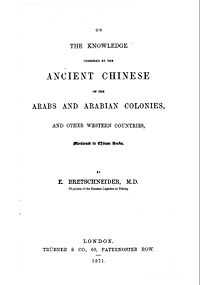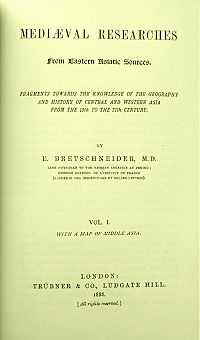Emil Bretschneider


by E.Bretschneider,M.D
Physician of Russian Legation in Peking
Correspondent member of Académie française
1888 London
Emil Bretschneider (4 July [O.S. 22 June] 1833 in Bankaushof (now Benkavas muiža, Saldus novads, Latvia[1]) – 12 May [O.S. 29 April] 1901 in Saint Petersburg) was a sinologist of Baltic German ethnicity and a correspondent member of Académie française. He operated in the Russian Empire. He graduated from the medical school of University of Dorpat in Dorpat Estonia, and was first posted as a physician by the Russian legation to Tehran (1862–65).[2] From 1866 to 1883 he was posted as physician by the Russian legation to Pekin.
Overview
In 1866 the publication of book titled "Cathay and the Way Thither" by orientalist Henry Yule stirred up Bretschneider's interest in sinology. However, he felt that the extensive material contained in Chinese books was under-utilized by western sinologists because many of them did not read Chinese, and when they quoted Chinese material, they relied on second hand sources. Emil Bretschneider while in Pekin, befriended the Archimandrite Palladius Kafarov of the Russian Orthodox Church Mission to Pekin, a famous sinologist in his own right; Bretschneider also took advantage of the excellent library of the Russian Ecclestic Mission with extensive collection of Chinese books on history, geography and botany, he began his own first hand research into ancient Chinese literature, particular in botany and geography.
In 1870 he published his first article in sinology: "Fu Sang-- Who discovered America ?", followed by the publication in London of "On the Knowledge Possessed by the Chinese of the Arabs and Arabian Colonies Mentioned in Chinese Books".[3]
In 1875 he published the article "Notes on Chinese medieval travellers to the West" in Shanghai.[4] In 1881 he published "Early European researches into the flora of China (American Presbyterian Mission Press, Shanghai), a topic often ignored by contemporary sinologists due to lack of training in botany. Bretschneider was a pioneer in this field.
In 1888 he published Mediaeval Researches from Eastern Asiatic Sources, Trubner Oriental Series, London; this book included his English translation of three important Chinese works about the history and geography of central Asia, namely Travel to The West by Yelü Chucai, Genghis Khan's chief adviser; Travels to the West by Taoist monk Kiu Chang Chun and The Peregrinations of Ye-Lu Hi-Liang (the grandson of Yelu Chucai), translated from The Annual of Yuan dynasty.
He was a correspondent member of the Académie française.
Work in botany
Bretschneider was less known as a botanist, having his own herbarium in the mountains close to Pekin. Starting in 1880, Bretschneider sent dried plant specimens to the Royal Botanic Gardens, Kew.[2]
Among the books he published in the field of botany are: "On the Study and Value of Chinese Botanical Works" (1870); "Early European Researches into the Flora of China" (1881); "Botanicum Sinicum" (1882); and his vast "History of European Botanical Studies in China" (1898).[2]
The plant species Bretschneidera sinensis was named in Bretschneider's honor.[2]
See also
References
- ↑ Baltisches Biographisches Lexikon digital, Brettschneider, Alexander Hermann Emil
- ↑ 2.0 2.1 2.2 2.3 Various (1901). "[In Memoriam for] Dr. Emil Bretschneider". Bulletin of miscellaneous information / Royal Botanic Gardens, Kew (London: Darling & Son, Ltd., for His Majesty's Stationery Office): 201–2. Retrieved 18 June 2013.
- ↑ E. Bretschneider, M.D. On Knowledge Possessed by the Ancient Chinese of the Arabs and Arabian Colonies and Other Western Countries Mentioned in Chinese Books, p17, Trubner & Co, London 1871
- ↑ E. Bretschneider, M.D: Notes on Chinese medieval travellers to the West (Shanghai: 1875)
- ↑ "Author Query for 'Bretschn.'". International Plant Names Index.
|